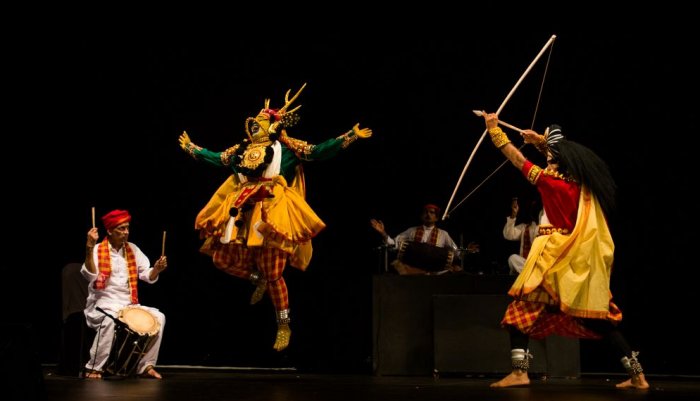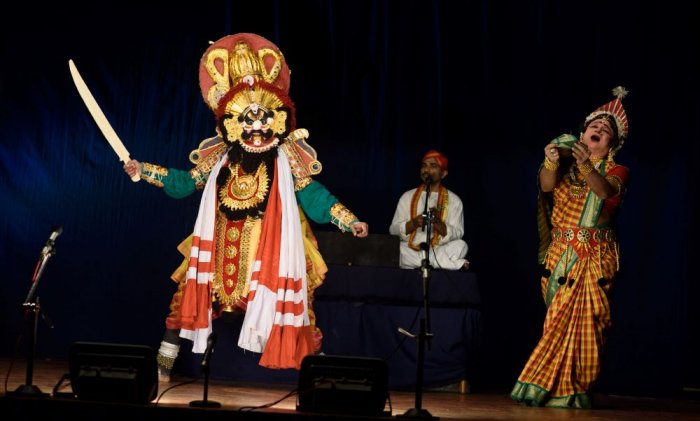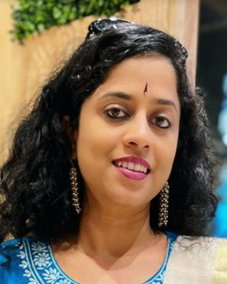
|   |

|   |
A magical evening of Yakshagana at the NMACC - Sumana Sachidananda e-mail: sumanas29@gmail.com Photos courtesy: Keremane Shivananda Hegde July 13, 2024 It was delightful to watch the legendary Keremane family present Yakshagana at the NMACC. An intimate set-up called the 'Cube' is ideal for such presentations, wherein the audience can immerse itself in the bhava and music. Yakshagana literally means song of the supernatural being. Yakshas are demigods. Yakshagana is considered a theatre style folk dance form, albeit with elements of classical dance. The team presented the episode of 'Seeta Apaharan' from Ramayana, an eternal favourite of audiences, and particularly relevant considering our zeitgeist (Ayodhya). The three musicians on the chande, maddale and vocals (with tala), occupied their places on stage at 7:30pm sharp. The NMACC has an open seating arrangement forcing rasikas to be punctual, lest they be supported by Indian Stretchable Time! The presentation commenced with a melodious Ganesha Vandana, where the two dancers described the various facets and traits of Ganesha, the remover of obstacles. The fast-paced knee whirls and jumps provided an energetic start to the performance. The two dancers looked very alike and in perfect sync. The story of Seeta's abduction by Ravana is known to all. But the beauty of this presentation lay in the poetic language, the impeccable mannerisms of every character and the soul stirring music. Shoorpanakha rushes to her elder brother Ravana. She describes the insult and pain suffered at the hands of the 'Maanavas' - Rama and Lakshmana. She says she went to eat them, instead found them to be too attractive and changed plans. She conveniently doesn't reveal that she lusted after them and attacked Seeta. Lakshmana then chopped her nose off in an act of defence. The enraged Ravana vows to kidnap Seeta and teach them a lesson. He goes to his uncle Mareecha, and orders him to distract Rama and Lakshmana away, so that he may abduct Seeta. Mareecha realises that death is knocking at his door - if he doesn't obey his nephew, Ravana will finish him off. At the same time, the almighty Rama will take his life if he attempts any foul play. Accepting his inevitable end, he approaches the kuteera at Panchavati in the guise of a golden deer (Swarna jinke). Here, we see the entry of a gorgeous Seeta in all her glory, replete with heavy ornaments and a lovely saree. The manner in which the dancer clutched the end of her pallu as she plucked flowers was so graceful and feminine, I couldn't believe it was a male dancer!  Rama and Mareecha The golden deer prances about, vanishing into thin air as Seeta tries to catch it. The young, innocent princess that she is, she pleads with Rama to bring the deer to her. When Rama explains to her that this is indeed no deer but a Mayavi whom he might kill, she says, "Then bring me the lifeless deer, I shall make a Kanchuka (upper body garment) from its hide." The humour in the conversation was refreshing and unique. Rama, the obedient and affectionate husband, reluctantly gives in to the tantrum of his lovely wife, and goes in search of the deer. The Ramayana and Mahabharata are evergreen epics as they are so relatable. They reveal common human weaknesses, errors and the struggles one must go through in life. There are lessons to be learnt in every chapter of these epics - for men and for women. One feels terribly sad for Lakshmana - the unblemished, faithful brother, who is wrongly accused by his sister-in-law Seeta for initially refusing to go save Rama, when they hear the cries of 'Hey Seeta, Hey Lakshmana!' Lakshmana appears to be the true hero of this story, with virtues of loyalty, selflessness, and devotion.  Ravana in his ghora roopa abducting Seeta The dancer in the role of Ravana with his booming voice and frightening expressions was remarkable. The abduction of a naive Seeta, the transformation of Ravana from his Sadhu roopa to his Ghora roopa (played by two different dancers in very different get-ups), the duel between Ravana and Jatayu, and the subsequent disappearance into Lanka, were all presented magnificently. Every performer was top-notch, making it hard to pick a favourite among them. The closing lines of the Mangala prayer which included the shloka Sarve Bhavantu Sukhinaha were rendered beautifully. The dancers then made a synchronized entry with folded hands for the curtain call. They received a well-deserved standing ovation! The sheer effort that goes behind such a performance - the elaborate make-up and costumes, voice culture, practising the dance movements, cultivating the character specific body language, developing mastery of the Kannada language dialogues which have to be improvised on spot, and being in total harmony with the accompanying artistes, is mind boggling. My attention didn't waver for a second, it was so gripping. 'Seeta Apaharan' by the Keremane troupe truly deserves many big platforms across the country. In the age of fusion and confusion, here is an undiluted Parampara thriving on absolute surrender to the art form. The music ensemble included Ananta Hegde Dantalige as Bhagawata (singer), Narasimha Hegde on the maddale and Raman Hegde on the chande. The performers were Keremane Shivanand Hegde as Rama, Timmappa Hegde as Mareecha, Sadashiva Bhat as Seeta, Ishwar Bhat as Ravana, Keremane Shridhar Hegde as Lakshmana, Vigneshwara Havagodi as Ghora Ravana, Chandrashekhar N as the golden deer, Vinayak Naik in Poorvaranga, Krishna Marathi in Poorvaranga and Ganapati Kunabi as Shoorpanakha.  Sumana Sachidananda is a Kathak dancer based in Mumbai. She is an MBA from ISB Hyderabad, and has also trained in Carnatic music. She holds a Senior Diploma in Kathak from Bharatiya Vidya Bhavan and is a DD graded artist. |